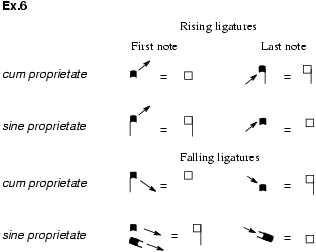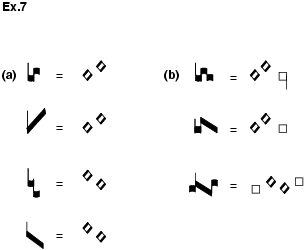
A notational symbol that combines within itself two or more pitches and by its shape defines their rhythm. It is in fact a rhythmicized neume of two or more notes. Between the 12th century and the 16th the ligature had a variety of causes, meanings and uses. Several of its ambiguities arise from its attempt to serve both as a neume (denoting several notes to be sung to a single syllable) and as a part of the rhythmic system; others arise because it was often merely a calligraphical flourish with no meaning beyond that of the note values it represented.
Its rhythmic implications follow a system that is historically logical but somewhat complicated in practice. Once established, towards the end of the 13th century, the system remained unchanged in principle but was used more and more selectively until by the 16th century only a single form of ligature was in common use. With the advent of type-set music the ligature eventually became extinct.
The earliest ligatures derive directly from the rising and falling two-note neumes of chant notation, the pes and the clivis (ex.1a). By the 12th century these had taken, in central French notation, the forms shown in ex.1b. How often these signs had any rhythmic implications in monophonic chant is still much discussed; but there seems to be general agreement that when they had rhythmic meaning they implied some kind of a drive towards the second note, which would become more accented and longer.

With the advent of modal notation for polyphony some time around 1200, the two signs in ex.1b became fundamental building-blocks of the system (see Rhythmic modes and Notation, §III, 2). The number of notes in each neume and the combination of such neumes in ordines defined the rhythms in the modal system; in the majority of cases these two neume-shapes were to be interpreted as breve–long (as in ex.2).
When the fully-fledged system of ligatures was described for the first time by Franco of Cologne (c1280) these two basic shapes retained their most common meanings, as in ex.2. Both shapes were described as being cum proprietate (‘with propriety’, i.e. with the first note in its standard form) and cum perfectione (‘with perfection’, i.e. with the last note in its standard form).

Alterations were made to these fundamental patterns by the addition or subtraction of stems, by turning notes round, or (for final notes only) by changing the shape of a ligature to an oblique form. Thus to turn round the last note of ex.2a as in ex.3a was to make it sine perfectione and to change its value from long to breve; the addition of a descending stem to that note would then restore its propriety, and therefore its original value (ex.3b).

Exx.3b and 2b are the two shapes fundamental to an understanding of ligatures. Any of the changes just mentioned had the effect of turning a long into a breve or equally – and this is perhaps the confusing point – turning a breve into a long. Thus to add a descending stem to the first note of ex.3b would have exactly the same effect as subtracting the descending stem from the first note of ex.2b – changing the value of that note from a breve to a long (ex.4). Similarly with final notes: the subtraction of the stem from the second note of ex.3b changed it from a long to a breve. For a descending ligature, however, a different technique was used. Here, to avoid confusion with liquescent neumes, the ligature was altered by conversion to the oblique form (ex.5). In all other cases the oblique form was identical in meaning with the normal square form of ligature: it changed only the final note, and then only when the ligature descended to that note.


This system, deriving directly from the concepts of propriety and perfection in the basic ligature forms in exx.3b and 2b, has two important characteristics: the scheme in the rising form of ligature is different from that in the falling form; and it applies only to the first and last notes of ligatures. Ex.6 shows all the possibilities.

Two further features complete the system. A rising stem denotes the beginning of a ligature cum opposita proprietate (‘with opposed propriety’): this is a ligature of two notes, each worth a semibreve (ex.7a). Whatever else may be happening in the ligature the two notes immediately following that rising stem are always semibreves (ex.7b). All other notes – that is to say, notes other than the first and last in a ligature and ones not covered by the cum opposita proprietate convention – have the value of a breve (ex.8), though a descending stem after any such note can turn it into a long (ex.9).



It is perhaps worth adding two points to the above explanation. First, while exx.2–9 are all in black-full notation they apply equally in the void notation that became customary in the 15th century. Second, the values of notes in ligature are of course subject to the same modifications as any other notes when used within the mensural system (see Notation, §III, 3).
This system grew up in the notation of melismatic tenors in the motet repertory of the late 13th century (though it is as well to bear in mind that many early motets are written in modal notation, an earlier system that works rather differently). In the 14th century it was used particularly in the untexted lower voices of secular songs and in the more melismatic sections in sacred music. Here, and in later music, scribes seem to have avoided placing ligatures so that more than one syllable must be sung to the ligature; and indeed the few discussions of texting in the theorists of the 15th and 16th centuries specifically forbid the singing of more than one syllable to a ligature. Yet there are many cases where there is no alternative to breaking the ligature for texting; and this rule should therefore be taken only as the norm, not as of universal application. As early as the 13th century the conflicting meanings of a neume (to denote several pitches for a single syllable) and of a ligature (to denote a particular rhythmic configuration) can often be seen leading to notational confusion.
In the 15th century, ligatures became increasingly rare. Some theorists of the time suggested that a ligature should be written whenever possible, and that to do otherwise would be to insult the musician. But there is very little evidence of this precept being followed at all rigorously. On the other hand, that state of mind may go some way to explaining why there is relatively little agreement among 15th-century sources in terms of ligatures that appear spasmodically. Several scholars have attempted, for example, to trace relationships between manuscripts by charting the ligature variants; but while such variants have often been recorded in the critical commentaries to editions, the findings in terms of manuscript filiation have in general proved inconclusive.
By the end of the 15th century there was in any case considerably less opportunity to write ligatures. As the minim and the semiminim became the most common note values, fewer and fewer occasions arose where a ligature of breve and long note values (as in exx.8 and 9) could be used. The cum opposita proprietate ligature of two semibreves therefore became almost the only form to appear; it can be found even in the 17th century. But long before that the ligature was in most cases only a scribal flourish, a more elegant way of writing notes. That ligatures were included in many printed editions of the 16th century – and even, occasionally, of the 17th – is no more significant than the retention of printers’ ligatures for normal letter-press typography.
For bibliography see Notation.
PETER WRIGHT